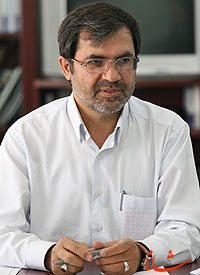Seyed Mahmoud Mohaddes, official in charge of Exploration Department of the National Iranian Oil Company, told reporters that early projections have estimated gas reserves of Zakhor gas field at 1.5 trillion cu. ft. (TCF), adding, “After drilling it was noticed that gas column was 800 m in height and the amount of in place gas reserves, was subsequently increased to 11.4 trillion cu. ft.
He noted that based on current forecasts the amount of in place gas reserves will increase subsequent to further drilling in the field.
The official noted that there were a number of exploration targets near Sefid Zakhor field, one of which is Halegan anticline (to the south of Sefid Zakhor) and drilling there will be started after drilling in Sefid Zakhor finishes.
Mohaddes noted that Halegan is a big anticline and drilling there will be started in 2-3 weeks.
“According to early estimates, the field can produce more than 1.15 billion cu. ft. gas per day and 17 more wells are needed to develop it,” he said.
Sefid Zakhor anticline is located in a mountainous area in Fars province, about 30 km south of Qir city.
Two-dimensional seismography was carried out to gain full information on the field in 2003 and the information has been processed and interpreted.
To carry out drilling in this field, a drilling rig was established at the location in the second half of 2005 and the first exploration well was drilled to a depth of 5,271 meters.
In place gas reserves of the field have been reported at 11.4 trillion cu. ft. while the amount of gas condensate has been estimated at 205 million barrels. Coefficients for gas and condensate production have been mentioned at 75 percent and 35 percent, respectively.
Director of Exploration Department of the National Iranian Oil Company further noted that the contract for developing Jofair oil field at Bangestan layers has been signed with Belarus, adding, “During the past 3-4 years, studies have been planned to explore deeper layers of the field and 3-D seismography is being carried out to take advantage of resultant information for development of Bangestan layer and explore Khami layer.
Mohaddes stated that Jofair oil field is located close to Azadegan oil field in the north of Darkhoein oil field and decision about explorative drilling on Khami layer was taken when oil was discovered in Khami layer of Azadegan and Darkhoein oil fields.
He said drilling in Jofair oil field has started since 1.5 months ago and out of 4,300 m of projected drilling, about 1,480 m has been accomplished.
The official stated that explorative drilling in the field aims at appraising Bangestan layers and exploration of Khami layer.
Director of Exploration Department of the National Iranian Oil Company stated that Paranj oil field is located midway between Kerenj and Parsi oil fields. He noted that after 3-D seismological studies were carried out on Kerenj and Parsi oil fields and the resultant data was explained, the Exploration reached the conclusion that the field can be appraised as an independent exploration goal.
Mohaddes noted that explorative drilling on Asmari horizon of Paranj oil field has been started since December 2005 and was finished in four months, adding that the field’s reserves were announced at 600 million to one billion barrels of crude oil in April 2006.
The official noted that since Paranj oil field is close to installations related to Parseh and Kerenj oil fields, production from the field has been started rapidly, adding, “Current production by Paranj oil field is about 7,000 barrels per day and the field’s output can be increased to 40,000-50,000 barrels per day.”
Mohaddes opined that the southern part of Paranj oil field can be explored too, adding, “A well is to be drilled in the southern part of the field and if the results were positive, explorative drilling in Paranj 2 will increase total reserves of the field.
He said exploration in Paranj field is low-cost and API of the field’s crude oil has been announced at 33.


Your Comment